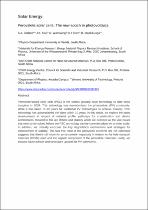JavaScript is disabled for your browser. Some features of this site may not work without it.
- ResearchSpace
- →
- Research Publications/Outputs
- →
- Journal Articles
- →
- View Item
| dc.contributor.author |
Olaleru, SA

|
|
| dc.contributor.author |
Kirui, JK

|
|
| dc.contributor.author |
Wamwangi, D

|
|
| dc.contributor.author |
Roro, Kittessa T

|
|
| dc.contributor.author |
Mwakikunga, Bonex W

|
|
| dc.date.accessioned | 2021-04-10T11:19:49Z | |
| dc.date.available | 2021-04-10T11:19:49Z | |
| dc.date.issued | 2020-01 | |
| dc.identifier.citation | Olaleru, S., Kirui, J., Wamwangi, D., Roro, K.T. & Mwakikunga, B.W. 2020. Perovskite solar cells: The new epoch in photovoltaics. <i>Solar Energy, 196.</i> http://hdl.handle.net/10204/11970 | en_ZA |
| dc.identifier.issn | 0038-092X | |
| dc.identifier.issn | 1471-1257 | |
| dc.identifier.uri | https://doi.org/10.1016/j.solener.2019.12.025 | |
| dc.identifier.uri | https://www.sciencedirect.com/science/article/pii/S0038092X19312393 | |
| dc.identifier.uri | http://hdl.handle.net/10204/11970 | |
| dc.description.abstract | Perovskite-based solar cells (PSC) is the fastest growing solar technology to date since inception in 2009. This technology has revolutionized the photovoltaic (PV) community. While it has taken 15–42 years for traditional PV technologies to achieve maturity, PSC technology has accomplished the same within 10 years. In this article, we explore the latest developments in respect of material profile, pathways for crystallization and device architectures. Related to this are lifetime and stability which are detected as the vital issues that need to be solved before the PSC technology can be commercialized on a wider scale. In addition, we critically elucidate the key degradation mechanisms and strategies for improvement of stability. The fact that most of the perovskite elements are not optimized suggests that there's still room for enhancement- especially in relation to the hole transport materials (HTMs) used and the organic component of the perovskite materials. Lastly, we discuss future outlook and necessary updates for PV community. | en_US |
| dc.format | Abstract | en_US |
| dc.language.iso | en | en_US |
| dc.source | Solar Energy, 196 | en_US |
| dc.subject | Perovskite | en_US |
| dc.subject | Photovoltaic | en_US |
| dc.subject | Perovskite-based solar cells | en_US |
| dc.subject | PSC | en_US |
| dc.subject | Solar cells | en_US |
| dc.title | Perovskite solar cells: The new epoch in photovoltaics | en_US |
| dc.type | Article | en_US |
| dc.description.pages | 295-309 | en_US |
| dc.description.note | © 2019 International Solar Energy Society. Due to copyright restrictions, the attached PDF file only contains the abstract of the full text item. For access to the full text item, please consult the publisher's website: https://www.sciencedirect.com/science/article/pii/S0038092X19312393 | en_US |
| dc.description.cluster | Smart Places | en_US |
| dc.description.impactarea | Energy Supply | en_US |
| dc.description.impactarea | NS Materials for Sensing App | |
| dc.identifier.apacitation | Olaleru, S., Kirui, J., Wamwangi, D., Roro, K. T., & Mwakikunga, B. W. (2020). Perovskite solar cells: The new epoch in photovoltaics. <i>Solar Energy, 196</i>, http://hdl.handle.net/10204/11970 | en_ZA |
| dc.identifier.chicagocitation | Olaleru, SA, JK Kirui, D Wamwangi, Kittessa T Roro, and Bonex W Mwakikunga "Perovskite solar cells: The new epoch in photovoltaics." <i>Solar Energy, 196</i> (2020) http://hdl.handle.net/10204/11970 | en_ZA |
| dc.identifier.vancouvercitation | Olaleru S, Kirui J, Wamwangi D, Roro KT, Mwakikunga BW. Perovskite solar cells: The new epoch in photovoltaics. Solar Energy, 196. 2020; http://hdl.handle.net/10204/11970. | en_ZA |
| dc.identifier.ris | TY - Article AU - Olaleru, SA AU - Kirui, JK AU - Wamwangi, D AU - Roro, Kittessa T AU - Mwakikunga, Bonex W AB - Perovskite-based solar cells (PSC) is the fastest growing solar technology to date since inception in 2009. This technology has revolutionized the photovoltaic (PV) community. While it has taken 15–42 years for traditional PV technologies to achieve maturity, PSC technology has accomplished the same within 10 years. In this article, we explore the latest developments in respect of material profile, pathways for crystallization and device architectures. Related to this are lifetime and stability which are detected as the vital issues that need to be solved before the PSC technology can be commercialized on a wider scale. In addition, we critically elucidate the key degradation mechanisms and strategies for improvement of stability. The fact that most of the perovskite elements are not optimized suggests that there's still room for enhancement- especially in relation to the hole transport materials (HTMs) used and the organic component of the perovskite materials. Lastly, we discuss future outlook and necessary updates for PV community. DA - 2020-01 DB - ResearchSpace DP - CSIR J1 - Solar Energy, 196 KW - Perovskite KW - Photovoltaic KW - Perovskite-based solar cells KW - PSC KW - Solar cells LK - https://researchspace.csir.co.za PY - 2020 SM - 0038-092X SM - 1471-1257 T1 - Perovskite solar cells: The new epoch in photovoltaics TI - Perovskite solar cells: The new epoch in photovoltaics UR - http://hdl.handle.net/10204/11970 ER - | en_ZA |
| dc.identifier.worklist | 24253 | en_US |






